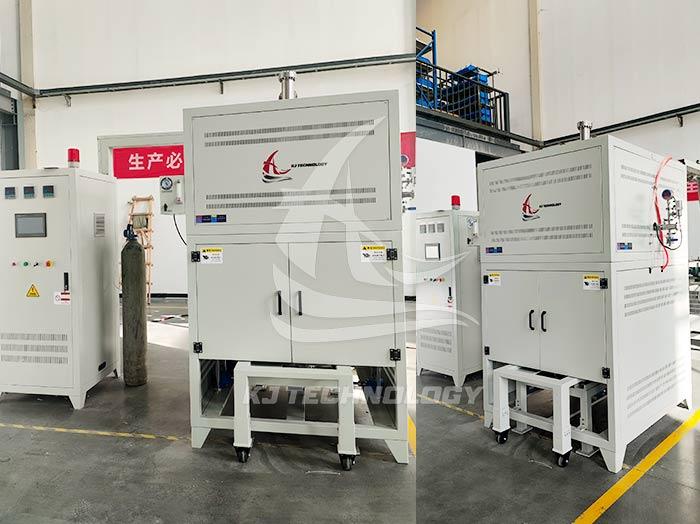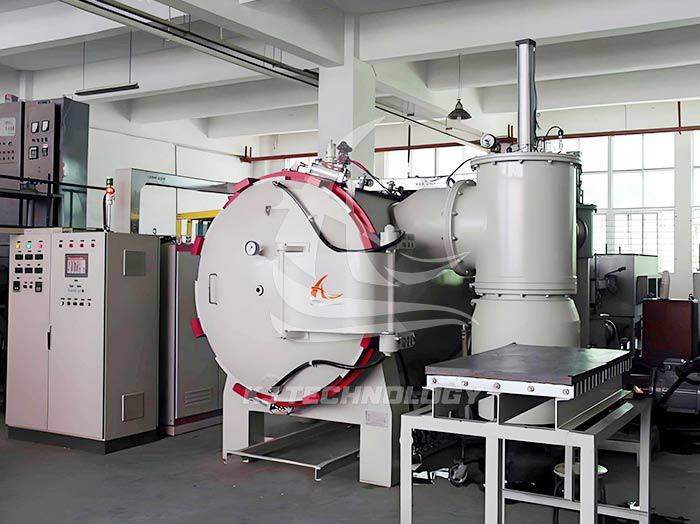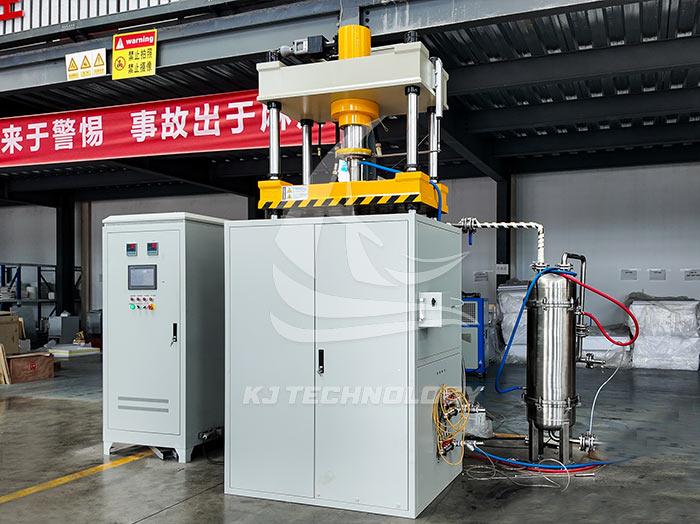Application of vacuum atmosphere muffle furnace in the battery industry
 09-12-2025 Author: KJ technology
09-12-2025 Author: KJ technology
The vacuum atmosphere muffle furnace is widely and crucially used in the battery industry. By precisely controlling the vacuum environment and atmosphere conditions, it significantly improves the performance, production efficiency, and resource utilization of battery materials. The specific application scenarios and effects are as follows:
1. Sintering of positive electrode material: improving battery performance and cycle life
High nickel ternary materials (such as NCM811)
Process optimization: In a vacuum or oxygen atmosphere, the material particle size distribution (D50 reduced from 5 μ m to 3 μ m) is controlled by gradient heating (such as pre firing at 300 ℃ → nucleation at 600 ℃ → grain growth at 850 ℃) to suppress agglomeration.
Performance improvement: The sintered NCM811 has a specific capacity of 220mAh/g, and after 500 cycles, the capacity retention rate is improved and the energy density is increased.
Enterprise case: After adopting a vacuum atmosphere furnace, a new energy enterprise has increased the annual production capacity of positive electrode materials and reduced production costs.
Lithium manganese iron phosphate (LMFP)
Carbon coating technology: Carbon coating treatment is carried out at 700 ℃, which increases the voltage platform and energy density.
Application effect: When LMFP material is used in power batteries, the range significantly increases and the cost is lower than that of ternary materials.
2. Negative electrode material processing: solving the problems of dendrite growth and cycling stability
Lithium metal negative electrode
Dendrite suppression: By combining vacuum tube furnace with atomic layer deposition technology, an inorganic protective layer (such as Al ₂ O3) is deposited on the surface of lithium metal, effectively suppressing dendrite growth.
Performance improvement: Cycle stability increased by 30%, Coulombic efficiency improved, significantly extending battery life.
Silicon based negative electrode
Carbon coating modification: In a vacuum or argon atmosphere, a carbon layer is coated on the surface of silicon particles by chemical vapor deposition (CVD) to alleviate the problem of volume expansion.
Application effect: The silicon-based negative electrode has a capacity of over 1000mAh/g and a higher capacity retention rate after 100 cycles, meeting the requirements of high-energy density batteries.
3. Solid state electrolyte synthesis: breaking through performance bottlenecks
Sulfide solid electrolyte
Anhydrous and oxygen free environment: High temperature sintering under inert atmosphere (such as argon) is achieved in a vacuum tube furnace through the integration interface of a glove box.
Performance improvement: The prepared electrolyte ion conductivity reaches 10 ⁻ S/cm (close to the level of liquid electrolyte), and the interface impedance is reduced, laying the foundation for the commercialization of solid-state batteries.
Oxide solid electrolyte (such as LLZO)
Atmosphere control: Sintering in an oxygen or nitrogen atmosphere to avoid lithium volatilization and improve material density.
Application effect: LLZO electrolyte has higher room temperature ionic conductivity, meeting the requirements of all solid state batteries.
4. Battery recycling and resource regeneration: achieving green manufacturing
Positive electrode material repair
Vacuum pyrolysis: Separate electrode materials and separators in a vacuum environment of 500-800 ℃, with high recovery rates for lithium, cobalt, and nickel.
Performance recovery: The specific capacity and cycle life of recycled materials are close to commercial products, reducing dependence on primary minerals.
Electrolyte recycling
Low temperature vacuum distillation: Under vacuum conditions of 100-200 ℃, organic solvents (such as EC and DMC) in the electrolyte are recovered with higher purity and can be recycled.
5. Process advantages and technological breakthroughs
Precise temperature control and atmosphere regulation
Temperature uniformity: Adopting alumina fiber furnace and gradient insulation design, the temperature difference inside the 1400 ℃ high temperature field is smaller, avoiding material cracking.
Atmosphere purity: By using a multi-channel gas mass flow controller (MFC), the oxygen partial pressure is controlled to meet the sintering requirements of high nickel materials.
energy saving and environmental protection
Energy efficiency optimization: The thermal conductivity of the alumina fiber furnace is small, which is more energy-efficient than traditional refractory bricks.
Low carbon technology: Developing hydrogen reduction processes to reduce carbon emissions, in line with the trend of green manufacturing.
6. Industry impact and future trends
The application of vacuum atmosphere muffle furnace has promoted the development of the battery industry towards high performance, low cost, and green direction. For example:
Solid state batteries: Synthesize high ion conductivity electrolytes in a vacuum environment to accelerate the commercialization process of solid-state batteries.
Sodium ion battery: Optimizing layered oxide cathode materials under vacuum conditions to improve sodium ion diffusion rate and reduce costs.
Intelligent upgrade: integrating AI algorithms and in-situ characterization technologies (such as XRD, Raman), real-time monitoring of material phase transition process, shortening the research and development cycle.








